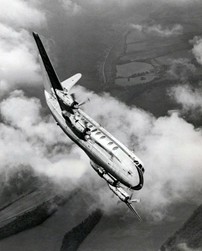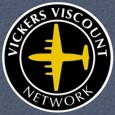
March 1956 to October 1957
British European Airways Corporation (BEA)
G-AOJA - c/n 150 - a V.802 series Viscount
United Kingdom registered
6 March 1956
Re-registered to British European Airways Corporation (BEA) from G-AOHA.
Although the reason for this registration change is not known, it is likely to have been done to avoid conflict operationally with V.701 Viscount G-ANHA (C/N 61).
Production Aircraft No. 1 - the 1st production V.800 series Viscount built,
was the 1st V.800 Viscount fuselage assembled at Hurn, Bournemouth, Hampshire, England,
and the 1st V.800 Viscount assembled at Weybridge, Surrey, England.
Production Order No. F01/802. Sales Order No. F01/63B. Stock Order No. F01/26B.
29 January 1956
Fuselage assembly commenced at Hurn Airport, Bournemouth, Hampshire, England.
April 1956
Fuselage transported by road from Hurn Airport, Bournemouth, Hampshire, England to Weybridge, Surrey, England.
3 April 1956
Fuselage to Erecting Shop 'E' at Weybridge, Surrey, England.
27 July 1956
First flight from Brooklands Airfield, Weybridge, Surrey, England which lasted for 55 minutes. It was flown by Gabriel (Gabe) Robb 'Jock' Bryce with Observer C A Mullen.
It landed at Wisley Airfield, Surrey, England but had to make a flapless landing as the flaps failed to lower.
The emergency flap drop system could have been selected but Jock wanted the ground crew to find out the cause of the failure so landed faster than normal, but with plenty of runway length to allow this. The No.3 Generator was also not operating.
Jock was not impressed with the overhead panels as some of the switches were up for on with others down for on.
The cockpit design was created to a specification issued by BEA, but it is not known if changes were made prior to delivery.
Unlike most production aircraft it often landed back at Brooklands Airfield, Surrey, England for modifications and further test flying.
The cabin was fitted out with a few seats and a test equipment cabinet.
On the interior port side wall there was a set of station numbers presumably as centre-of-gravity datums.

SBAC show at Farnborough, Hampshire, England
September 1956
Exhibited at the Society of British Aircraft Constructors (SBAC) air show at Farnborough Airfield, Hampshire, England.
26 November 1956
Officially named as ‘R M A Sir Samuel White Baker’ by Lady Douglas during a ceremony held at Wisley Airfield, Surrey, England.
28 November 1956
Departed from Wisley Airfield, Surrey, England on test flight number 90 with cine cameras installed to observe the behaviour of the ailerons and shrouds during steep dives from 30,000 feet.
The flight was flown by T S Harris with G R Poulter as the Observer and it lasted for 55 minutes before returning to Wisley.
Aircraft total time 110 hours 25 minutes.
10 December 1956
Noted at Blackbushe Airport, Hampshire, England carrying out crew training flights.
7 February 1957
Departed from Wisley Airfield, Surrey, England on test flight number 122 on the acceptance test schedule specified by BEA.
The flight was flown by Richard 'Dickie' Rymer with G R Poulter as the Observer and it lasted for 1 hours and 50 minutes before returning to Wisley.
Aircraft total time 158 hours 20 minutes.
11 February 1957
Certificate of Airworthiness (CofA) issued.
14 February 1957
Departed from Wisley Airfield, Surrey, England on delivery to British European Airways (BEA) named as 'R M A Sir Samuel White Baker'.
23 October 1957
Crashed at 16:51 local time at Nutts Corner Airport, Belfast, Northern Ireland with the loss of 5 crew and 2 passengers.
The aircraft was on a special charter flight from London Airport (Heathrow), Middlesex, England to pick up the Minister of Supply, Aubrey Jones, and a party of London pressmen who had been attending the opening of a research building for Short Brothers & Harland Ltd at Queen's Island, Belfast, Northern Ireland.
Commanded by Captain Robert M Stewart, 35, of Ruislip, Middlesex, England who had completed a Viscount V.802 conversion course in March 1957. His co-pilot was First Officer William G Tompkins, 35, of Felden, Hemel Hempstead, Hertfordshire, England who had served with the RAF (Royal Air Force) during World War II and had been awarded the DFC (Distinguished Flying Cross).
The other crew members were Stewardess J A Medhurst of Rochester, Kent, England; Steward E Bebington of Hounslow, West Middlesex, England, and Steward A Hall of Newcastle-upon-Tyne, England. The passengers were Mr John Galpin a senior BEA - British European Airways sales representative in Northern Ireland, and his wife Irene.
Before Captain Stewart left London Airport he was told there was a cold front approaching Belfast from the north and the landing conditions to be expected at Nutts Corner would be some cloud down to 300 feet, but that improvement was likely from 4pm. As the aircraft crossed over Portaferry in County Down, Northern Ireland, Captain Stewart considered diverting to Collinstown Airport, Dublin, Ireland because of the prevailing weather conditions. The air traffic control zone co-ordinator and supervisor at Nutts Corner told Captain Stewart that, despite a number of bad cloud reports that afternoon, aircraft had been becoming visual round about 500-600 feet and said it might be worth his while coming down to his critical height to see whether he could make an approach. Captain Stewart replied that he would try that.
As the aircraft descended towards Nutts Corner Airport the possibility of diverting to nearby RAF Aldergrove was also discussed but Captain Stewart said he would make an approach into Nutts Corner. At 4.39 pm, air traffic control said Captain Stewart had a 'sporting chance' of becoming visual above his critical height.
At 16:45 with the aircraft at 2,200 feet and on a heading of 285 degrees the flight was handed over to the Precision Approach Controller for a GCA (Ground Controlled Approach) talk down to runway 28. Within a mile from touchdown the aircraft had drifted right of the runway centre line. A 'go-around' was initiated, but the aircraft crashed 1,000 feet south of the western end of runway 28.
Four witnesses who were on the ground to the right of the Viscount's approach path to the runway threshold were the only people who saw the aircraft before it crashed.
Only one of them mentioned that the landing wheels were down. All four heard the Viscount's engines 'rev-up'.
The crash happened at 4.51 pm. Reports state that nobody saw the crash but a number of people heard it. The engines were running up to the moment of impact when there was a vivid flash followed by the noise of an explosion. The crash resulted in the almost complete disintegration of the aircraft.
The accident investigators found that at the moment of impact all three of the Viscount's undercarriage units were fully retracted and locked. The court investigation concluded that the undercarriage was down as it made its approach and was then retracted as the aircraft began its 'go-around'.
Everything recovered from the wreckage was subjected to an exhaustive examination by aviation experts, but they failed to find anything that pointed to the malfunctioning of any instrument or indicator that could have led the pilot into a disastrous operation of the controls. Neither was there any evidence that pilot error contributed to the accident.
Total time 1,473 hours and 1,000 total landings.
8 July 1958
A public enquiry commenced in London and examined all the evidence including a deformed 6 inch screwdriver which was found in the crash debris. Unfortunately someone had straightened it before handing it in. It was thought that it may have interfered with the Aileron controls but no solid proof was ever obtained.
The Court Investigation therefore concluded that the crash 'must remain a wholly unexplained calamity'.
25 August 1958
The Ministry of Transport & Civil Aviation issued their accident report C.A.P.150 which dismissed, amongst others the screwdriver theory and confirmed that a conclusion could not be found based on the lack of evidence.
 FURTHER READING: Books about BEA - British European Airways FURTHER READING: Books about BEA - British European Airways
|



